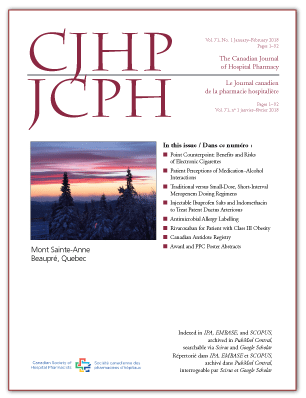Effectiveness of Injectable Ibuprofen Salts and Indomethacin to Treat Patent Ductus Arteriosus in Preterm Infants: Observational Cohort Study
DOI:
https://doi.org/10.4212/cjhp.v71i1.1725Keywords:
ductus arteriosus, patent, infant, newborn, indomethacin, ibuprofen, ibuprofen arginine, persistance du canal artériel, nouveau-né, nourrisson, indométhacine, ibuprofène, ibuprofène arginineAbstract
ABSTRACT
Background: There is no injectable ibuprofen product marketed to treat patent ductus arteriosus (PDA) in newborns in Canada. The authors’ institution has used ibuprofen arginine in the past. In the absence of published evidence supporting use of this salt form of ibuprofen for neonatal PDA, a retrospective analysis was undertaken.
Objective: To compare the effectiveness and adverse effects of ibuprofen arginine, ibuprofen tromethamine, and indomethacin in the treatment of PDA.
Methods: This retrospective observational cohort study, for patients admitted between 2009 and 2015, included preterm infants with symptomatic PDA who received at least one dose of injectable indomethacin, ibuprofen tromethamine, or ibuprofen arginine. Three effectiveness end points were analyzed: closure after one course of treatment, repeat medical treatment, and surgical ligation. The secondary end points included acute kidney injury, necrotizing enterocolitis, chronic lung disease, and time to full enteral feeding.
Results: A total of 179 infants were included. There were no differences among groups in terms of closure after one course of treatment (37/54 [69%] with indomethacin, 42/70 [60%] with ibuprofen tromethamine, and 28/55 [51%] with ibuprofen arginine; p = 0.21) or surgical ligation (10/54 [19%] with indomethacin, 13/70 [19%] with ibuprofen tromethamine, and 12/55 [22%] with ibuprofen arginine; p = 0.88). However, there was a difference regarding use of a repeat course of treatment, ibuprofen arginine having the highest rate (8/54 [15%] with indomethacin, 18/70 [26%] with ibuprofen tromethamine, and 20/55 [36%] with ibuprofen arginine; p = 0.04). After adjustment for gestational age, the association between ibuprofen arginine and increased use of a repeat course of treatment remained significant. The groups did not differ with respect to adverse effects.
Conclusion: These results highlight the potential for differences in effectiveness among various salt forms of injectable ibuprofen and indomethacin. Because of the small sample size and retrospective methodology, confirmation of the present results through a larger prospective study is needed.
RÉSUMÉ
Contexte : Il n’y a pas sur le marché de produit injectable à base d’ibuprofène pour traiter la persistance du canal artériel (PCA) chez le nouveau-né au Canada. L’ibuprofène arginine a été utilisé auparavant dans l’établissement de santé des auteurs. En l’absence de données publiées appuyant l’utilisation de ce médicament sous forme de ce sel pour traiter la PCA chez le nouveau-né, une analyse rétrospective a été réalisée.
Objectif : Comparer l’efficacité et les effets indésirables de l’ibuprofène arginine, de l’ibuprofène trométhamine et de l’indométhacine dans le traitement de la PCA.
Méthodes : Cette étude de cohorte observationnelle rétrospective, au sujet de patients hospitalisés entre 2009 et 2015, incluait des nourrissons prématurés atteints d’une PCA symptomatique ayant reçu par injection au moins une dose d’indométhacine, d’ibuprofène trométhamine ou d’ibuprofène arginine. Trois paramètres d’évaluation de l’efficacité ont été analysés : la fermeture après un seul traitement, la répétition du traitement médical et la ligature chirurgicale. Les paramètres d’évaluation secondaires étaient les cas d’insuffisance rénale aiguë, d’entérocolite nécrosante et de maladie pulmonaire chronique ainsi que le temps pour atteindre l’alimentation entérale complète.
Résultats : Au total, 179 nourrissons ont été admis à l’étude. Aucune différence n’a été relevée entre les groupes en ce qui touche à la fermeture après un seul traitement (37/54 [69 %] pour l’indométhacine, 42/70 [60 %] pour l’ibuprofène trométhamine et 28/55 [51 %] pour l’ibuprofène arginine; p = 0,21) ou à la ligature chirurgicale (10/54 [19 %] pour l’indométhacine, 13/70 [19 %] pour l’ibuprofène trométhamine et 12/55 [22 %] pour l’ibuprofène arginine; p = 0,88). Cependant, une différence a été observée pour ce qui est de la répétition du traitement et l’ibuprofène arginine a obtenu le taux le plus élevé (8/54 [15 %] pour l’indométhacine, 18/70 [26 %] pour l’ibuprofène trométhamine et 20/55 [36 %] pour l’ibuprofène arginine; p = 0,04). Après ajustement pour l’âge gestationnel, l’association entre l’utilisation de l’ibuprofène arginine et une augmentation du recours à un second traitement demeurait significative. Il n’y avait pas de différence entre les groupes en ce qui touche aux effets indésirables.
Conclusion : Ces résultats soulignent la possible différence d’efficacité parmi les divers sels d’ibuprofène injectable et l’indométhacine. Cependant, en raison de la petite taille de l’échantillon et de l’emploi d’une méthodologie rétrospective, une étude prospective plus importante doit être menée pour confirmer les résultats de la présente étude.
Downloads
Published
Issue
Section
License
Copyright © Canadian Society of Healthcare-Systems Pharmacy.
After publication of a manuscript in the CJHP, the authors of the manuscript must obtain written permission from the CSHP (publications@cshp.ca) before reproducing any text, figures, tables, or illustrations from the work in future works of their own. If a submitted manuscript is declined for publication in the CJHP, all said rights shall revert to the authors. Please note that any forms (e.g., preprinted orders and patient intake forms) used by a specific hospital or other health care facility and included as illustrative material with a manuscript are exempt from this copyright transfer. The CJHP will require a letter from the hospital or health care facility granting permission to publish the document(s).










